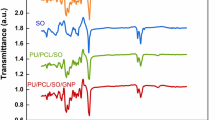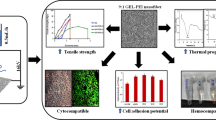Abstract
This study aimed to explore a potential use of fish scale-derived gelatin nanofibrous scaffolds (GNS) in tissue engineering due to their biological and economical merits. Extraction of gelatin was achieved via decalcification, sonication and lyophilization of mixed fish scales. To fabricate nano-scale architecture of scaffolds analogous to natural extracellular matrix, gelatin was rendered into nanofibrous matrices through 6-h electrospinning, resulting in the average diameter of 48 ± 12 nm. In order to improve the water-resistant ability while retaining their biocompatibility, GNS were physically crosslinked with ultraviolet (UV) irradiation for 5 min (UGN5), 10 min (UGN10) and 20 min (UGN20). On average, the diameter of nanofibers increased by 3 folds after crosslinking, however, Fourier transform infrared spectroscopy analysis confirmed that no major alterations occurred in the functional groups of gelatin. A degradation assay showed that UGN5 and UGN10 scaffolds remained in minimum essential medium for 14 days, while UGN20 scaffolds degraded completely after 10 days. All UGN scaffolds promoted adhesion and proliferation of human keratinocytes, HaCaT, without causing an apparent cytotoxicity. UGN5 scaffolds were shown to stimulate a better growth of HaCaT cells compared to other scaffolds upon 1 day of incubation, whereas UGN20 had a long-term effect on cells exhibiting 25% higher cell proliferation than positive control after 7 days. In the wound scratch assay, UGN5 scaffolds induced a rapid cell migration closing up to 79% of an artificial wound within 24 h. The current findings provide a new insight of UGN scaffolds to serve as wound dressings in the future.

In the wound scratch assay, UGN5 induced a rapid cell migration closing up to 79% of an artificial wound within 24 h.







Similar content being viewed by others
References
Singer AJ, Dagum AB. Current management of acute cutaneous wounds. N Engl J Med. 2008;359:1037–46.
Demidova-Rice TN, Hamblin MR, Herman IM. Acute and impaired wound healing: pathophysiological and current methods for drug delivery, part 1: normal and chronic wounds: biology, causes, and approaches to care. Adv Skin Wound Care. 2012;25:304–14.
Ogurtsova K, da Rocha Fernandes JD, Huang Y, et al. IDF Diabetes Atlas: Global estimates for the prevalence of diabetes for 2015 and 2040. Diabetes Res Clin Pract. 2017;128:40–50.
Posnett J, Franks PJ. The burden of chronic wounds in the UK. Nurs Times. 2008;104:44–5.
Sood A, Granick MS, Tomaselli NL. Wound dressings and comparative effectiveness data. Adv Wound Care. 2014;3:511–29.
Frantz C, Stewart KM, Weaver VM. The extracellular matrix at a glance. J Cell Sci. 2010;123(Pt 24):4195–200.
Gnavi S, Fornasari BE, Tonda-Turo C, et al. The influence of electrospun fibre size on Schwann cell behavior and axonal outgrowth. Mater Sci Eng: C. 2015;48:620–31.
Ghaly AE, Ramakrishnan VV, Brooks MS, Budge SM, Dave D. Fish processing wastes as a potential source of protein. Amino Acids and Oils: A Critical Review. J Microb Biochem Technol. 2013;5:107–29.
Boran G, Mulvaney SJ, Regenstein JM. Rheological properties of gelatin from silver carp skin compared to commercially available gelatins from different sources. J Food Sci. 2010;75:E565–71.
Herpandi H, Huda N, Adzitey F. Fish bone and scale as a potential source of Halal gelatin. J Fish Aquat Sci. 2011;6:379–89.
Badami AS, Kreke MR, Thompson MS, Riffle JS, Goldstein AS. Effect of fiber diameter on spreading, proliferation and differentiation of osteoblastic cells on electrospun poly (lactic acid) substrates. Biomaterials. 2006;24:596–606.
Chua KN, Chai C, Lee PC, et al. Surface-aminated electrospun nanofibers enhance adhesion and expansion of human umbilical cord blood hematopoietic stem/progenitor cells. Biomaterials. 2006;27:6043–51.
Agarwal S, Wendorff JH, Greiner A. Use of electrospinning technique for biomedical applications. Polymer. 2008;49:5603–21.
Bigi A, Cojazzi G, Panzavolta S, Rubini K, Roveri N. Mechanical and thermal properties of gelatin films at different degrees of glutaraldehyde crosslinking. Biomaterials. 2001;22:763–8.
Zhang YZ, Venugopal J, Huang ZM, Lim CT, Ramakrishna S. Crosslinking of the electrospun gelatin nanofibers. Polymer. 2006;47:2911–7.
Sisson K, Zhang C, Farach-Carson MC, Chase DB, Rabolt JF. Fiber diameters control osteoblastic cell migration and differentiation in electrospun gelatin. J Biomed Mater Res Part A. 2010;94:1312–20.
Huang-Lee LL, Cheung DT, Nimni ME. Biochemical changes and cytoxicity associated with the degradatin of polymeric glutaraldehydge derived crosslinks. J Biomedical Materials Part A. 1990;24:1185–201.
Gough JE, Scotchford CA, Downes S. Cytotoxicity of glutaraldehyde crosslinked collagen/poly (vinyl alcohol) films is by the mechanism of apoptosis. J Biomed Mater Res A. 2002;61:121–30.
Weadock KS, Miller EJ, Bellincampi LD, Zawadsky JP, Dunn MG. Physical crosslinking of collagen fibers: Comparison of ultraviolet irradiation and dehydrothermal treatment. J of Biomed Mater Res. 1995;29:1373–9.
Kato Y, Nishikawa T, Kawakishi S. Formation of protein‐bound 3,4‐dihydroxyphenylalanine in collagen types i and iv exposed to ultraviolet light. Photochem Photobiol. 1995;61:367–72.
Lew DH, Liu PHT, Orgill DP. Optimization of UV cross‐linking density for durable and nontoxic collagen GAG dermal substitute. J Biomed Mater Res Part B: Appl Biomater. 2007;82B:51–6.
Lin WH, Tsai WB. In situ UV-crosslinking gelatin electrospun fibers for tissue engineering applications. Biofabrication. 2013;5:035008.
Masutani EM, Kinoshita CK, Tanaka TT, Ellison AK, Yoza BA. Increasing thermal stability of gelatin by UV-induced cross-linking with glucose. Int J Biomate. 2014;2014:979636.
Mori M, Hamamoto A, Nakano M. Effects of ultraviolet LED on bacteria. World Congress on Medical Physics and Biomedical Engineering. 2006;2:1327–30.
Tu ZC, Huang T, Wang H. Physico-chemical properties of gelatin from bighead carp (Hypophthalmichthys nobilis) scales by ultrasound-assisted extraction. J Food Sci Technol. 2015;52:2166–74.
Huang C-Y, Kuo J-M, Wu S-J, Tsai H-T. Isolation and characterization of fish scale collagen from tilapia (Oreochromis sp.) by a novel extrusion-hydro-extraction process. Food Chem. 2016;190:997–1006.
Gómez-Guillén MC, Turnay J, Fernández-Dı́az MD, Ulmo N, Lizarbe MA, Montero P. Structural and physical properties of gelatin extracted from different marine species: a comparative study. Food Hydrocoll. 2002;16:25–34.
Laemmli UK. Cleavage of structural proteins during the assembly of the head of bacteriophage T4. Nature. 1970;227:680–5.
Nuge T, Tshai KY, Lim SS, Nordin N, Hoque ME. Preparation and characterization of CU-, FE-, AG-, ZN- and NI- doped gelatin nanofibers for possible applications in antibacterial nanomedicine. J Eng Sci Technol. 2017;12:68–81.
Zhou P, Mulvaney SJ, Regenstein JM. Properties of Alaska pollock skin gelatin: A comparison with tilapia and pork skin gelatins. J Food Sci. 2006;71:C313–21.
Lin CC, Chiou TK, Sung WC. Characteristics of Gelatin from Giant Grouper (Epinephelus Lanceolatus) skin. Int J Food Prop. 2015;18:2339–48.
Song X, Dong P, Gravesande J, Cheng B, Xing J. UV-mediated solid-state cross-linking of electrospinning nanofibers of modified collagen. Int J Biol Macromol. 2018;120:2086–93.
Yslas EI, Cavallo P, Acevedo DF, Barbero CA, Rivarola VA. Cysteine modified polyaniline films improve biocompatibility for two cell lines. Mater Sci Eng: C. 2015;51:51–6.
Lutolf MP, Hubbell JA. Synthetic biomaterials as instructive extracellular microenvironments for morphogenesis in tissue engineering. Nat Biotechnol. 2005;23:47–55.
Xu CY, Inai R, Kotaki M, Ramakrishna S. Aligned biodegradable nanofibrous structure: a potential scaffold for blood vessel engineering. Biomaterials. 2004;25:877–86.
Kumbar SG, Nukavarapu SP, James R, Nair LS, Laurencin CT. Electrospun poly (lactic acid-co-glycolic acid) scaffolds for skin tissue engineering. Biomaterials. 2008;29:4100–7.
Min BM, Lee G, Kim SH, Nam YS, Lee TS, Park WH. Electrospinning of silk fibroin nanofibers and its effect on the adhesion and spreading of normal human keratinocytes and fibroblasts in vitro. Biomaterials. 2004;25:1289–97.
Cooper DR, Davidson RJ. The effect of ultraviolet irradiation on collagen-fold formation. Biochemical J. 1966;98:655–61.
Fujimori E. Changes induced by ozone and ultraviolet light in type I collagen. European J Biochem. 1985;152:299–306.
Sionkowska A. Modification of collagen films by ultraviolet irradiation. Polym Degrad Stab. 2000;68:147–51.
Wang X, Li X, Yost MJ. Microtensile testing of collagen fibril for cardiovascular tissue engineering. J Biomed Mater Res. 2005;74:263–8.
Muyonga JH, Cole CGB, Duodu KG. Fourier transform infrared (FTIR) spectroscopic study of acid soluble collagen and gelatin from skins and bones of young and adult Nile perch (Lates niloticus). Food Chem. 2004;86:325–32.
Byler DM, Susi H. Examination of the secondary structure of proteins by deconvolved FTIR spectra. Biopolymers. 1986;25:469–87.
Ohan MP, Weadock KS, Dunn MG. Synergistic effects of glucose and ultraviolet irradiation on the physical properties of collagen. J Biomed Mater Res. 2002;60:384–91.
Davidenko N, Bax DV, Schuster CF, Farndale RW, Hamaia SW, Best SM, Cameron RE. Optimisation of UV irradiation as a binding site conserving method for crosslinking collagen-based scaffolds. J Mater Sci: Mater Med. 2016;27:14.
Cooper DR, Davidson RJ. Tthe effect of ultraviolet irradiation on soluble collagen. Biochem J. 1965;97:139–47.
Sudbeck BD, Pilcher BK, Welgus HG, Parks WC. Induction and repression of collagenase-1 by keratinocytes is controlled by distinct components of different extracellular matrix compartments. J Biol Chem. 1997;272:22103–10.
Rahsaz M, Geramizadeh B, Kaviani M, Marzban S. Gelatin for purification and proliferation of primary keratinocyte culture for use in chronic wounds and burns. Exp Clin Transplant. 2015;13:361–5.
Liang HC, Chang WH, Liang HF, Lee MH, Sung HW. Crosslinking structures of gelatin hydrogels crosslinked with genipin or a water‐soluble carbodiimide. J Appl Polym Sci. 2004;91:4017–26.
Kanade S, Nataraj G, Ubale M, Mehta P. Fluorescein diacetate vital staining for detecting viability of acid-fast bacilli in patients on antituberculosis treatment. Int J Mycobacteriol. 2016;5:294–98.
Fu X, Xu M, Liu J, Qi Y, Li S, Wang H. Regulation of migratory activity of human keratinocytes by topography of multiscale collagen-containing nanofibrous matrices. Biomaterials. 2014;35:1496–506.
Jafari J, Emami SH, Samadikuchaksaraei A, Bahar MA, Gorjipour F. Electrospun chitosan–gelatin nanofiberous scaffold: Fabrication and in vitro evaluation. Biomed Mater Eng. 2011;21:99–112.
Das RP, Jain AK, Ramesh V. Current concepts in the pathogenesis of psoriasis. Indian J Dermatol. 2009;54:7–12.
Takashi K, Folmer J, Coulombe PA. Increased expression of keratin 16 causes anomalies in cytoarchitecture and keratinization in transgenic mouse skin. J Cell Biol. 1994;127:505–20.
Acknowledgements
This study was conducted under the collaboration of Faculty of Science and Faculty of Engineering and funded by The University of Nottingham Malaysia Campus.
Author information
Authors and Affiliations
Corresponding authors
Ethics declarations
Conflict of interest
The authors declare that they do not have any conflict of interest.
Additional information
Publisher’s note: Springer Nature remains neutral with regard to jurisdictional claims in published maps and institutional affiliations.
Rights and permissions
About this article
Cite this article
Beishenaliev, A., Lim, S.S., Tshai, K.Y. et al. Fabrication and preliminary in vitro evaluation of ultraviolet-crosslinked electrospun fish scale gelatin nanofibrous scaffolds. J Mater Sci: Mater Med 30, 62 (2019). https://doi.org/10.1007/s10856-019-6264-4
Published:
DOI: https://doi.org/10.1007/s10856-019-6264-4




